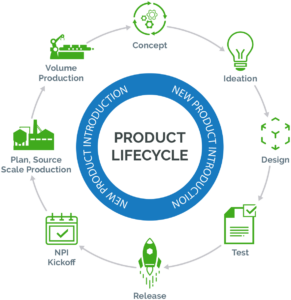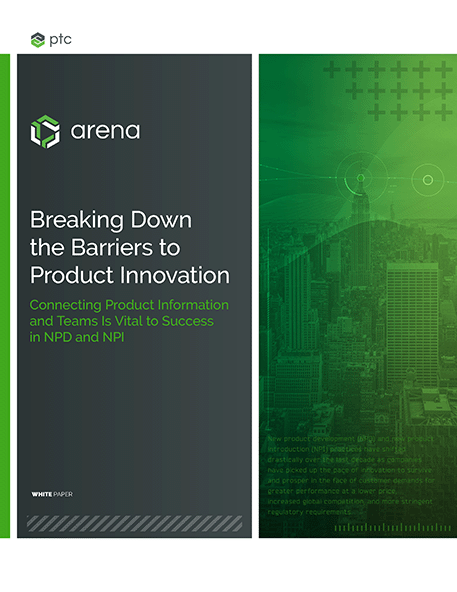Streamline New Product Introduction (NPI)
The Challenge
 Getting high-quality products to market fast is more complicated than ever. Distributed teams use many different tools and share information with external chain partners, increasing the chances for miscommunication and production errors like building to the wrong revision.
Getting high-quality products to market fast is more complicated than ever. Distributed teams use many different tools and share information with external chain partners, increasing the chances for miscommunication and production errors like building to the wrong revision.
In addition, constant competitive pressures drive companies to innovate more rapidly to get new products to market fast.
NPI Focus and Reliance on NPD Processes
New product introduction (NPI) and new product development (NPD) are often referred to in the same way or confused by many. Both are required to get products to market, but each focuses on different aspects of the product realization process.
NPD focuses more on early development to finalize the product design and requires a lot of iteration to get the product ready for handoff to operations. NPI overlaps with NPD, but focuses more on getting operations teams and supply chain partners aligned around the final released product design to effectively plan, produce, and ramp to volume production.
While NPI and NPD vary in focus, they are very complementary and require a comprehensive, unified plan to bring products and teams together from concept through volume production.
NPI Requires Control, Connection, and Collaboration
 Once your NPD team has completed the released design comprised of the full product record, operations teams jump into high gear to begin planning to realize that design and move into full production mode. To do this well, consider these three key recommendations for success:
Once your NPD team has completed the released design comprised of the full product record, operations teams jump into high gear to begin planning to realize that design and move into full production mode. To do this well, consider these three key recommendations for success:
- Control. You need a single unified solution with a single source of truth during the NPI and NPD stages. This ensures that engineering, operations, and supplier partners will leverage the right information at the right time. Part of this control includes maintaining not only the latest release revision of your product record, but historical information should issues arise later. Securing access by each team should be done based on role-based privileges that guarantee teams only see WHAT they need, WHEN they need it. Giving manufacturing teams access to earlier revisions and designs would create confusion, scrap and rework, and costly delays when leveraged incorrectly.
- Connection. Not only do NPD and NPI processes need to be connected as you progress from early design to production planning, but all related processes should be connected to the product record. This includes engineering changes (ECOs), project plans and tasks, quality and CAPA records, and training record management for related standard operating procedures (SOPs). Connecting processes and records ensures visibility and full context to the product record foundation, unlike disconnected tools such as spreadsheets, emails, and other stand-alone documents like MS Word.
- Collaboration. Once all information, processes, and teams are connected in a single system, you can enable fast collaboration. Collaboration should support formal gated collaboration and approval processes like automated engineering change order reviews that are connected to the product record. In addition, informal collaboration should allow for shared discussion threads in between the spaces of formal collaboration to share insights and potential concerns with the product design. Having a simple, web-based cloud solution enables even the least technical of teams around the world to easily access and collaborate around the product. Systems should be easy to set up, configure, and use. Having a cloud-based application removes not only infrastructure hurdles, but it provides a simpler and more intuitive way for teams to share information without intensive system training.
Wired for NPI Success
With a single system of record to connect teams, product designs, quality processes, and training records, you will be wired for NPI success. The handoff from NPD will be seamless and allow downstream operations and supply chain partners to “hit the ground running” to meet product launch goals. With increased visibility, operations will be able to scale and share information with all impacted teams quickly and securely. Planning production on the latest revision will eliminate unnecessary scrap and rework, ensure suppliers have provided the right parts for the lowest cost, and keep the entire product coming together as procurement and manufacturing drive to delivery dates based on forecasted demand.
Arena’s product development platform includes product lifecycle management (PLM) and quality management system (QMS) management in the Cloud. We make it easy for anyone, anywhere, to access the latest product and quality information. Our single source of truth encompasses the complete product record (e.g., electrical, mechanical, software) that enables internal teams and supply chain partners to move from early concept through volume production seamlessly. Arena PLM and QMS streamline product launch processes to reduce costs, speed time to market, and help you gain first-mover advantages in the marketplace. To learn more about how Arena helps global product innovators deliver products, click here.
Need More Help?
Check out our Guide to New Product Introduction for even more free advice on essential elements of the NPI process.



